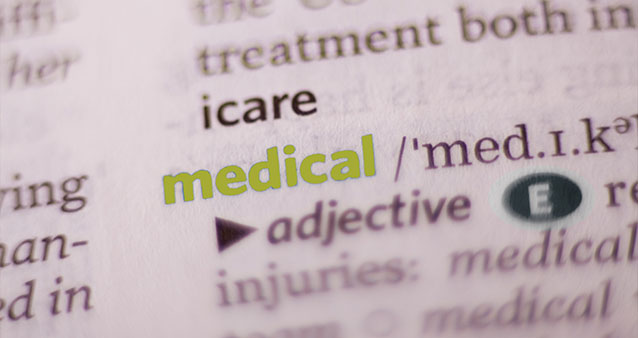Medical Aid: Terms You Need to Know

Reviewing your medical aid once a year is important—benefits, savings amounts, and costs tend to change annually, and you need make sure that your medical aid plan is still doing for you what it needs to do.
But even before that, it helps to get to know the ins and outs of the medical aid world. There are a lot of terms that are similar, like medical scheme and medical aid plan, and terms that are acronyms, like MSA and PMB. These can get confusing, so we're busting down the 'huh?' and giving you a look into some of the most common medical aid terms we think you should know about.
Acute Medicine
This is when medicine is given to you or prescribed by a doctor for a short period of time. It's important to know about because medical aids usually pay for acute medications out of your medical savings account, rather than out of the chronic benefit.
Chronic Condition
This refers to a health condition that you suffer from for more than three months at a time. Any time less than that and it's considered to be an acute condition. Medical aids will pay a certain amount for your chronic condition if it's on the list of prescribed minimum benefits (PMBs)—more on this later on. Keep in mind that medical aid schemes have different amounts they'll pay per chronic condition, depending on the plan you're on.
Co-Payment
A co-payment is an amount the scheme asks you to pay when you have a medical procedure or get meds from your doctor. Think of it as you paying for a portion of the medical costs. This is important because different medical schemes and plans will ask you to make a specified co-payment amount. It's also vital to consider when you're on a network plan, because, if you visit a healthcare provider or medical facility that isn't on the defined list of networks, your medical aid is probably going to ask you to make a co-payment.
Designated Service Provider
This has to do with network options. A designated service provider (DSP) is a healthcare provider or healthcare facility (like a private hospital) that is on the list of service providers that you can visit when you're on a network plan—that is, if you' don't want to make a hefty co-payment!

Emergency
Knowing what a medical emergency is, is important when you're trying to understand PMBs, one of which is cover for emergencies. This could include a stroke, heart attack, or life-or-death injuries from a car accident. What this means is that if you're on a medical aid, whether it's the most basic hospital plan, a high-MSA plan, or most importantly, a network plan, the medical aid is legally obliged to pay for your treatment at any private hospital in South Africa until you're stable enough to be moved to a facility on the DSP list.
Formulary
This is a fancy way of describing the list of medications that your scheme has approved to treat an illness or disease. If you have a chronic condition or another type of illness or disease, the medical aid will agree to pay for all (or a portion) of the cost of certain medicines, but not others. This list of allowed medications is known as the formulary.
ICD Codes
Less commonly known as the International Code of Diseases and Related Problems, these are codes that the medical scheme uses to identify every medical condition and diagnosis you can think of. When you apply for your medical aid to pay for a chronic condition, for example, your doctor will write down certain codes in their motivation to the scheme to indicate which disease you've been diagnosed with, so the medical aid knows which treatments and medications to approve.
Late-Joiner Penalty
If you're at or over the age of 35 and have never been on a medical aid in South Africa before (including as a child dependant), you're charged a late-joiner penalty. If you were on a medical aid but then had a break in cover for longer than three months in a row, the same penalty applies. The amount a scheme is allowed to charge you is regulated. Here's a quick overview of the percentage you can expect to pay depending on how long you were uncovered from the age of 35 years old.
| Number of years you haven't been a member of a registered medical scheme upon turning 35 years old | Late-joiner penalty |
|---|---|
| 1 to 4 years | 5% of contribution |
| 5 to 14 years | 25% of contribution |
| 15 to 24 years | 50% of contribution |
| 25+ years | 75% of contribution |
Medical Aid Plan
This might seem like a simple one, but it's easy to mistake a medical aid for a medical scheme. The former is the specific plan you're on—the benefits that you pay for. These include private hospital cover, medicines, and doctors.
Some of the more well-known medical schemes in South Africa include Bestmed, Bonitas, CompCare, Discovery, Fedhealth, Keyhealth, Medihelp, Medshield, Momentum, and Profmed.
Medical Savings Account
Also known as the MSA, this is a portion of your medical aid payments, usually 15% or 25%, that is kept aside for day-to-day expenses. It might cover your monthly medication (that which isn't covered under the chronic benefit), GP visits, specialist visits, and out-of-hospital meds. The MSA belongs to you, but you can't spend it on anything you like. For example, it might not pay out for certain vitamins, or nappies and baby formula. Or those odds and sods that quickly add up at your favourite pharmacy.
Medical Scheme
This is the overarching company that provides you with the plan that you're on—not to be confused with the medical aid plan itself.
Medical Schemes Act
This is the Act in law that governs the behaviour of medical schemes in South Africa. It decides what schemes can and can't do and what medicinal and hospital benefits they must offer.
Prescribed Minimum Benefits
Also known as PMBs, these are a defined list of 271 medical conditions, 26 chronic conditions and all medical emergencies. By law, every medical scheme has to pay for—at the very least—a portion of the costs of the conditions, diseases, or injuries associated with the PMBs. Even if you're on a plan that only comes with hospital benefits, your scheme is obliged to pay for these.
Solvency Ratio
Regulation 29 of the Medical Schemes Act requires all medical schemes to maintain accumulated funds of at least 25% of the total annual contributions. This is in place to ensure the financial sustainability of medical aid schemes and to provide peace of mind to consumers. All of the best medical aid schemes in the country have good solvency ratios, and this is something to consider when you're choosing a provider, because you want one that is stable and in good financial standing.
Waiting Periods
These are periods of time that a medical aid will make you wait before allowing you to claim. There are general waiting periods, which include a category of cover, such as not being able to claim for specialist visits, and condition-specific waiting periods, where you need to wait a certain amount of time before the scheme will pay out for a pre-existing condition. This usually applies when you switch schemes in the middle of the year, rather than waiting for 1 January to switch.
Now that we've given you the lowdown on some important medical aid terms, it's time to compare with hippo! You could save a ton of money just by viewing medical aid quotes side by side, along with their benefits and savings, if applicable. Hippo it today to start saving!
This article is for informational purposes only and should not be construed as financial, legal or medical advice.
Hippo Blog Categories


































